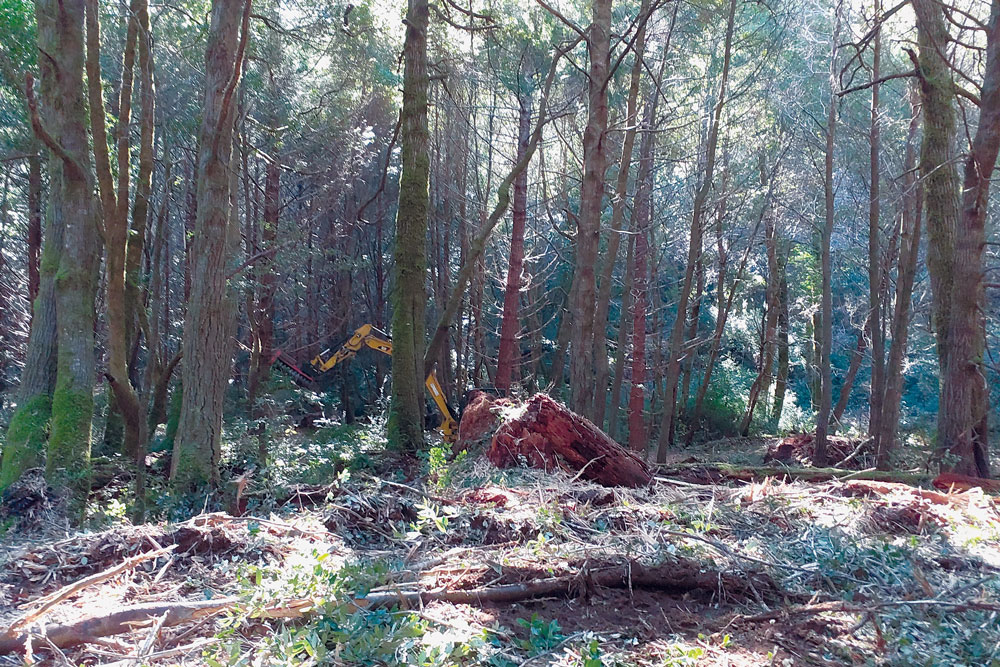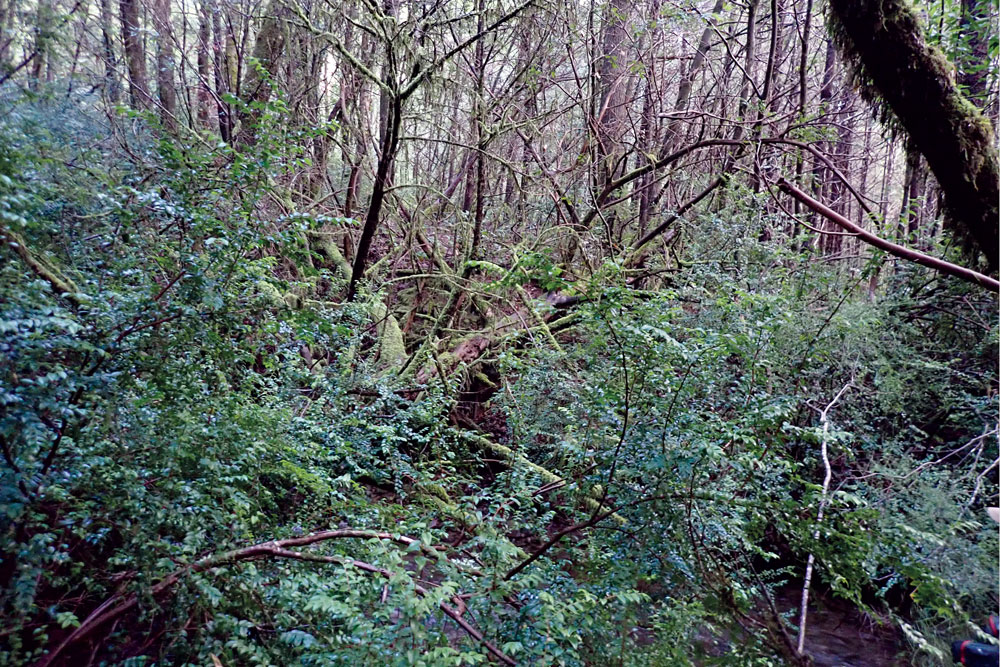Living With Fire
Restoring Fire Resilience in the Mattole River Headwaters

Sanctuary Forest
By Ash Brookens, Tasha McKee, and April Newlander
Sanctuary Forest (SFI) holds title to more than 800 acres of forestland in the Mattole River headwaters. The group is committed to stewardship practices that will reduce wildfire risk and promote forest health, as well as improve streamflows and riparian habitat. In February 2022, SFI began forest improvement work on an approximately 200-acre property in Anderson Creek, as part of the Anderson Creek Instream and Riparian Habitat Restoration Project, which aims to reduce fuel loads and increase species diversity. Industrial logging practices, combined with decades of fire suppression, have resulted in overly dense, even-aged forests that pose a significant fire risk to the surrounding community. In addition, younger trees have higher evapotranspiration rates which contributes to significantly lower dry-season flows. [Editors Note: Evapotranspiration is the sum of evaporation from the land surface plus transpiration from plants.] Widespread removal of large wood from streams has resulted in reduced groundwater storage, increased channel incision, and loss of floodplain connectivity. In turn, this has impacted the diversity of riparian vegetation, with tanoak and Douglas-fir encroachment along the streambanks.

Photo courtesy Sanctuary Forest archives
Anderson Creek Property Project Details
The project will entail forest thinning on approximately 23 acres (13 acres in the riparian zone, and 10 acres upslope) of the Anderson Creek property. The project objectives will be achieved by retaining larger mature trees, cutting most of the small trees (under 10” diameter), and then planting native riparian trees and sedges along the creek. By retaining and thinning around the larger mature trees, a supply of large wood debris will be established along the stream corridor, adding complexity to the channel crucial to improving instream fish habitat. Reducing tree density will correspondingly reduce both fuel loads and evapotranspiration, creating a more drought- and fire-resilient landscape.
In order to minimize impacts, careful consideration is always given to the appropriateness of equipment utilized. For this reason, hand felling is the primary method employed when working within riparian zones, with judicious use of heavy equipment restricted to easily accessible areas. Practices such as lop-and-scatter and/or chipping of slash will help build up the mulch layer and promote rainwater infiltration. This points to a useful synergy in this stewardship approach, in that it has the potential to enhance streamflows and restore natural ecological processes in the long term, while carrying the immediate benefit of mitigating fire risk to the community. The next phase of the project, slated for summer 2022, will include the direct placement of cut trees along 3,000 feet of stream for improved salmonid habitat and increased streamflow benefits.
Fire-conscious Forest Stewardship
Fire-conscious forest stewardship is needed at a watershed scale, and SFI is currently planning fire-resilience projects in McKee and Vanauken Creeks—the gateway to the Mattole headwaters and future sites for public access. In addition to these efforts, SFI is working with Humboldt County and the Mattole Restoration Council on a regional roadside fuels-reduction project that includes treatments along Briceland-Thorn Road, providing a safe exit route in the case of wildfire. Mattole Restoration Council will be completing the fuels-reduction work later this year, with SFI assisting with local landowner outreach. Whitethorn residents who own property along the county road can expect to hear from SFI as the project start date nears.
The planning and implementation team for the Anderson Creek Instream and Riparian Habitat Restoration Project includes SFI, Consulting Forester Timothy Metz, Campbell Thompson from the Mattole Salmon Group, Logan Edwards of Edwards Excavation & Restoration, and the Natural Resources Conservation Service (NRCS). Funding for this project comes from the NRCS EQIP Program ($44,118) and CA Department of Fish & Wildlife’s Environmental Enhancement Fund ($238,542). Sanctuary Forest thanks everyone working together to coinhabit a more fire-resilient landscape in the Mattole River headwaters.
For more information: www.sanctuaryforest.org
